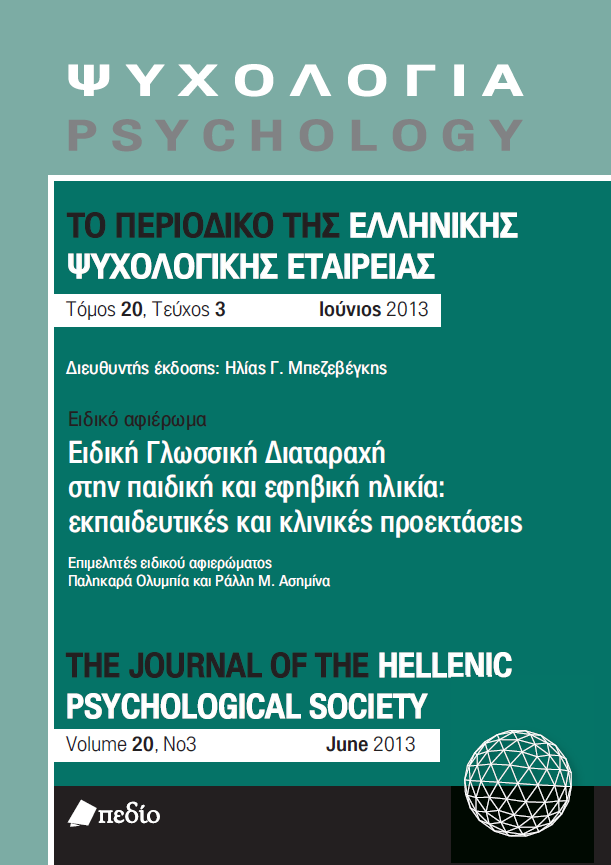Γλωσσικά ελλείμματα και κινητική ασυμμετρία σε παιδιά με Ειδική Γλωσσική Διαταραχή.

Περίληψη
H παρούσα μελέτη διερευνά την πιθανότητα σύνδεσης των γλωσσικών ελλειμμάτων και της κινητικής ασυμμετρίας άνω και κάτω άκρων παιδιών με Ειδική Γλωσσική Διαταραχή (ΕΓΔ). Aξιολογήσαμε τις γλωσσικές ικανότητες και την προτίμηση χεριού και ποδιού σε 13 παιδιά με ΕΓΔ και δύο ομάδες παιδιών τυπικής ανάπτυξης, μία που είχε εξισωθεί με τα παιδιά με ΕΓΔ ως προς τη γλωσσική ηλικία (ΓΗ) και μία ως προς τη χρονολογική ηλικία (ΧΗ). Συγκεκριμένα, ελέγξαμε την παραγωγή αναφορικών προτάσεων αντικειμένου, ερωτηματικών προτάσεων
αντικειμένου και σιγματικού αορίστου για ψευδορήματα που δεν ομοιοκαταληκτούν με υπαρκτά ρήματα και χορηγήσαμε ερωτηματολόγια προτίμησης χεριού και ποδιού. Βρέθηκαν σημαντικές διαφορές μεταξύ των ομάδων στα γλωσσικά έργα καθώς η ομάδα παιδιών με ΕΓΔ είχε χαμηλότερη επίδοση από την ομάδα ελέγχου ΧΗ ενώ στα ερωτηματολόγια προτίμησης χεριού και ποδιού οι ομάδες δεν παρουσίασαν την ίδια επίδοση. Επιπλέον ανάλυση έδειξε απουσία συσχέτισης μεταξύ της προτίμησης χεριού και ποδιού στα παιδιά με ΕΓΔ σε αντίθεση με την ομάδα ελέγχου ΧΗ. Η ανάλυση παλινδρόμησης έδειξε ότι η προτίμηση ποδιού μπορεί να προβλέψει την ένταξη του παιδιού στην ομάδα παιδιών με ΕΓΔ. Τα αποτελέσματα φανερώνουν ενδεχομένως μειωμένο συντονισμό μεταξύ χεριού και ποδιού και αυξημένη πιθανότητα μη δεξιάς προτίμησης ποδιού σε παιδιά με ΕΓΔ. Ερμηνεύουμε τα ευρήματα αυτά ως αποτέλεσμα κινητικής ανωριμότητας των παιδιών με ΕΓΔ και ως ένδειξη χαμηλής συσχέτισης μεταξύ της κινητικής πλευρίωσης και των γλωσσικών ελλειμμάτων. Συζητούμε τις επιπτώσεις των ευρημάτων στο χαρακτηρισμό των ελλειμμάτων στην ΕΓΔ.
Λεπτομέρειες άρθρου
- Πώς να δημιουργήσετε Αναφορές
-
Γώγου Α., Σταυρακάκη Σ., Γρούϊος Γ., & Τσιγγίλης Ν. (2020). Γλωσσικά ελλείμματα και κινητική ασυμμετρία σε παιδιά με Ειδική Γλωσσική Διαταραχή. Ψυχολογία: το περιοδικό της Ελληνικής Ψυχολογικής Εταιρείας, 20(3), 285–301. https://doi.org/10.12681/psy_hps.23542
- Τεύχος
- Τόμ. 20 Αρ. 3 (2013)
- Ενότητα
- ΕΙΔΙΚΟ ΑΦΙΕΡΩΜΑ

Αυτή η εργασία είναι αδειοδοτημένη υπό το Creative Commons Attribution-ShareAlike 4.0 International License.
Το περιοδικό ΨΥΧΟΛΟΓΙΑ έχει υιοθετήσει μία πολιτική Platinum open-access. Τα έξοδα υποβολής, επεξεργασίας ή δημοσίευσης των εργασιών καλύπτονται από την Ελληνική Ψυχολογική Εταιρεία. Τα πνευματικά δικαιώματα των δημοσιευμένων εργασιών προστατεύονται από την άδεια 'Creative Commons Attribution-ShareAlike 4.0 International'. Οι Συγγραφείς διατηρούν τα Πνευματικά Δικαιώματα και χορηγούν στο περιοδικό το δικαίωμα της πρώτης δημοσίευσης. Η άδεια αυτή επιτρέπει σε τρίτους, να χρησιμοποιούν την εργασία σε οποιαδήποτε μορφή, με την προϋπόθεση της διατήρησης των διατυπώσεων που προβλέπονται στην άδεια σχετικά με την αναφορά στον αρχικό δημιουργό και την αρχική δημοσίευση στο περιοδικό ΨΥΧΟΛΟΓΙΑ. Επιπλέον, κάθε διανομή της εργασίας οφείλει να γίνεται με τους ίδιους όρους διανομής, δηλαδή με την ίδια άδεια Creative Commons.



